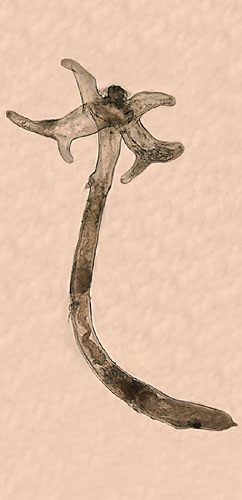18-06-2019
Pollution in rivers enhances the presence of the anchor worm in freshwater fish
Poorly treated waters that reach rivers and the runoff of agricultural areas can boost the spreading of the anchor worm –an exotic species that parasites freshwater fish- in the peninsular water network, according to a study in which the experts Alberto Maceda Veiga, from the Biodiversity Research Institute (IRBio) of the University of Barcelona, and Adolfo de Sostoa, from the Faculty of Biology and IRBio –have taken part.
Other participants in the article, published in the journal International Journal for Parasitology, are Ralph Mac Nally (University of Canberra, Australia), Andy J. Green (Doñana Biological Station, EBD-CSIC) and Robert Poulin (University of Otago, New Zealand).
Other participants in the article, published in the journal International Journal for Parasitology, are Ralph Mac Nally (University of Canberra, Australia), Andy J. Green (Doñana Biological Station, EBD-CSIC) and Robert Poulin (University of Otago, New Zealand).
Anchor worm: an invasive crustacean that came from the Asian continent
The anchor worm (Lernaea cyprinacea) is an invasive species from Asia that affects freshwater fish –cyprinids and salmonids, in particular- and causes many economic losses in fish farms. In the peninsula, this copepod crustacean was first identified in 1973 in River Esla, in León. Today, the anchor worm is almost in all the planet and its spreading is associated with recreational activities in rivers and international commerce of fish for aquaculture.
“The parasitic fauna –native and exotic- affecting freshwater fish in the peninsula is still quite unknown, especially the cyprinids, the most common family of fish in the peninsula and the European continent”, says Alberto Maceda, member of IRBio and EBD-CSIC.
“Freshwater fish are one of the most threatened animal group worldwide –he continues- and one of the factors could be their growing vulnerability regarding pathogens that enter natural ecosystems”.
The new study assesses those factors associated with episodes of parasitism in L. cyprinacea in nineteen fish species (carp, common trout, eel, barbell, mosquitofish, etc.). In particular, the experts analyse how changes affect the quality of water and the natural habitat in the dispersal of the anchor worm in hydrographic basins in the northern eastern area of the peninsula –Catalonia, Ebro River and Garona River- which are affected by common environmental stress factors in a great part of the water systems worldwide.
More informationThe anchor worm (Lernaea cyprinacea) is an invasive species from Asia that affects freshwater fish –cyprinids and salmonids, in particular- and causes many economic losses in fish farms. In the peninsula, this copepod crustacean was first identified in 1973 in River Esla, in León. Today, the anchor worm is almost in all the planet and its spreading is associated with recreational activities in rivers and international commerce of fish for aquaculture.
“The parasitic fauna –native and exotic- affecting freshwater fish in the peninsula is still quite unknown, especially the cyprinids, the most common family of fish in the peninsula and the European continent”, says Alberto Maceda, member of IRBio and EBD-CSIC.
“Freshwater fish are one of the most threatened animal group worldwide –he continues- and one of the factors could be their growing vulnerability regarding pathogens that enter natural ecosystems”.
The new study assesses those factors associated with episodes of parasitism in L. cyprinacea in nineteen fish species (carp, common trout, eel, barbell, mosquitofish, etc.). In particular, the experts analyse how changes affect the quality of water and the natural habitat in the dispersal of the anchor worm in hydrographic basins in the northern eastern area of the peninsula –Catalonia, Ebro River and Garona River- which are affected by common environmental stress factors in a great part of the water systems worldwide.
Image: U.S. Geological Survey
